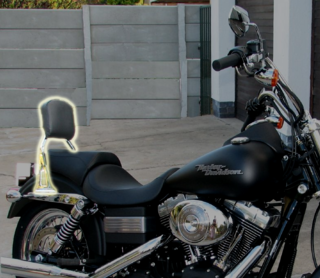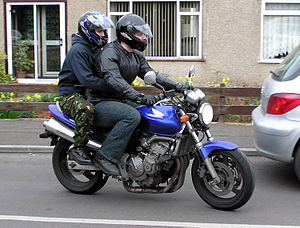
A motorcycle is a two or three-wheeled motor vehicle steered by a handlebar from a saddle-style seat.
An L-plate is a square plate bearing a sans-serif letter L, for learner, which must be affixed to the front and/or back of a vehicle in many countries if its driver is a learner under instruction, or a motorcycle rider with provisional entitlement to ride restricted motorcycles.

A motorcycle club is a group of individuals whose primary interest and activities involve motorcycles. A motorcycle group can range as clubbed groups of different bikes or bikers who own same model of vehicle like the Harley Owners Group.

A sissy bar, also called a "sister bar" or "passenger backrest" is an addition to the rear of a bicycle or motorcycle that allows the rider or passenger to recline against it while riding. Alternatively it can serve as an anchor point or support for mounting luggage or equipment that is not part of the bike. They can serve as one of the main mounts securing the rear fender to the motorcycle. Over the years the sissy bars have been a focal point of expression for the bike builder. Custom sissy bar designs can be simple or extravagant. They can be built for comfort, purpose, style or a combination of all three.

Motorcycle safety is the study of the risks and dangers of motorcycling, and the approaches to mitigate that risk, focusing on motorcycle design, road design and traffic rules, rider training, and the cultural attitudes of motorcyclists and other road users.
Graduated driver licensing systems (GDLS) are designed to provide new drivers of motor vehicles with driving experience and skills gradually over time in low-risk environments. There are typically three steps or stages through which new drivers pass. They begin by acquiring a learner's permit, progress to a restricted, probationary or provisional license, followed by receipt of a full driver's license. Graduated drivers' licensing generally restricts nighttime, expressway, and unsupervised driving during initial stages, but lifts these restrictions with time and further testing of the individual, eventually concluding with the individual attaining a full driver's license.
A driver's permit, learner's permit, learner's license or provisional license is a restricted license that is given to a person who is learning to drive, but has not yet satisfied the prerequisite to obtain a driver's license. Having a learner's permit for a certain length of time is usually one of the requirements for applying for a full driver's license. To get a learner's permit, one must typically pass a written permit test, take a basic competency test in the vehicle, or both.
Many countries have enacted electric vehicle laws to regulate the use of electric bicycles, also termed e-bikes. Some jurisdictions have regulations governing safety requirements and standards of manufacture. The members of the European Union and other regions have wider-ranging legislation covering use and safety.

A motorcycle taxi, or cart bike or bike taxi, is a licensed form of transport in some countries. The taxi typically carries one passenger, who "rides pillion" behind the motorcycle operator. Multiple passengers are common in some countries.
Freeways in some East Asian countries and areas, namely Mainland China, South Korea and Taiwan have restrictions on motorcycles that are not widely implemented elsewhere around the world, such as access restrictions, limits on carrying passengers, and different speed limits, frequently due to safety concerns.

Snatch theft is a criminal act, common in Southeast Asia, South America, and Southern Europe, of forcefully stealing a pedestrian's personal property by employing rob-and-run tactics.
A motorcycle rally is a gathering of motorcycle enthusiasts. Rallies can be large or small, and one-time or recurring. Some rallies are ride-in events, whereas some like the Iron Butt Rally involve days of riding and an actual gathering only at the end of the ride.

The Big RuckusPS250 is a 250cc, CVT transmission-equipped two-seater scooter, manufactured by Honda; marketed in Japan for model years 2004-2007 and in North America for model years 2005-2006 — and noted for its minimal bodywork and expressed light-weight steel tubular frame, akin to the Honda Zoomer.
Illegal taxicabs, sometimes known as pirate taxis, gypsy cabs, or jitney cabs, are taxicabs and other for-hire vehicles that are not duly licensed or permitted by the jurisdiction in which they operate. Most major cities worldwide require taxicabs to be licensed, safety-inspected, insured as for-hire vehicles and use taximeters and there may also be requirements that the taxi driver be registered or accredited. However, many unlicensed cabs are in operation. Illegal cabs may be marked taxi vehicles, and others are personal vehicles used by an individual to offer unauthorized taxi-like services. Illegal cabs are prevalent in cities with medallion systems, which restrict the number of legal cabs in operation. Since their introduction in 2009, vehicles affiliated with the transportation network company Uber have been classified as illegal taxicabs in some jurisdictions.

In Canada, driver's licences are issued by the government of the province or territory in which the driver is residing. Thus, specific regulations relating to driver's licences vary province to province, though overall they are quite similar. All provinces have provisions allowing non-residents to use licences issued by other provinces and territories, out-of-country licences, and International Driving Permits. Many provinces also allow non-residents to use regular licences issued by other nations and countries. Canadian driver's licences are also valid in many other countries due to various international agreements and treaties.
In India, a driving licence is an official document that authorises its holder to operate various types of motor vehicles on highways and some other roads to which the public has access. In various Indian states, they are administered by the Regional Transport Authorities/Offices (RTA/RTO). A driving licence is required in India by any person driving a vehicle on any highway or other road defined in the Motor Vehicles Act, 1988. This act sets limits on the minimum age for vehicle operation ranging from 16 to 20, depending on specific circumstances. A modern photo of the driving licence can also serve many of the purposes of an identity card in non-driving contexts such as proof of identity or age.
Motorcycle accessories are features and accessories selected by a motorcycle owner to enhance safety, performance, or comfort, and may include anything from mobile electronics to sidecars and trailers. An accessory may be added at the factory by the original equipment manufacturer or purchased and installed by the owner post-sale as aftermarket goods. The term Farkle is used within the motorcycle community, originally to denote useful add-ons, such as GPS or other upgraded components. Now also used at times in a humorous or mildly derogatory way to describe bling, such as anodized or chromed parts that add no functionality.
The legal definition of a motorcycle for the purposes of registration, taxation and rider licensing in most countries is a powered two-wheel motor vehicle. Most countries distinguish between mopeds up to 49 cc and the more powerful, larger, vehicles known as motorcycles. Many jurisdictions include some forms of three-wheelers as motorcycles.
This is a glossary of motorcycling terms.
Danell Lynn is an American long distance motorcycle rider. As of 2016, she holds the Guinness record for the world's longest motorcycle journey in a single country. She is the first woman to earn the record riding solo.








